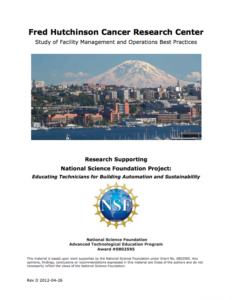Fred Hutchinson Cancer Research Center: Study of Facility Management and Operations Best Practices

This 20 page case study, from the Building Efficiency for a Sustainable Tomorrow (BEST) National Center, provides an overview of the facility management, maintenance, and operations of the Fred Hutchinson Cancer Research Center in Seattle. Best practices are highlighted to "provide snap-shots of selected areas of excellence that crystallized as particularly significant to the successful operations of each facility." These cover activities that meet end use requirements, improve cost effectiveness, reduce energy consumption and encourage energy consumption awareness, improve occupant comfort, or meet sustainability goals. "Best practices span excellence in technology and design strategies, troubleshooting and problem solving, proactive organizational management and strategic planning, education and training efforts, and shared leadership." In addition, this case study provides a facility overview, background of the Fred Hutchinson Cancer Research Center Campus buildings and systems, and information on facility staff. A best practice highlighted is participation in design for the building life cycle, including active involvement in design and construction, application of a design standard, participation in design reviews, value engineering and commissioning. Another best practice is understanding the building's mission and use by supporting the core mission, sizing and resizing equipment, and participating in occupant education by creating user guides. Other best practices include applying an energy philosophy, retaining and increasing tribal (collective institutional) knowledge, and always having a contingency plan for system and equipment failures. Each best practice highlighted is accompanied by a section outlining the skills and knowledge required for implementation. A "Summary of Best Practices" in the form of a table is provided at the end.

Comments